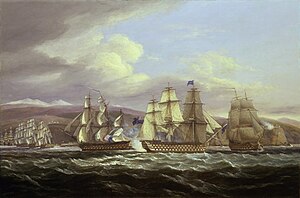Blokade (militær)
 For alternative betydninger, se Blokade. (Se også artikler, som begynder med Blokade)
For alternative betydninger, se Blokade. (Se også artikler, som begynder med Blokade)
En blokade er et forsøg på med fysisk magt at afskære et område fra adgang til forsyninger, krigsmateriel eller kommunikation, enten helt eller delvist. En blokade må ikke forveksles med en embargo eller sanktioner, som begge er juridiske blokeringer for handel. Det er også noget andet end en decideret belejring, idet en blokade typisk er rettet mod et helt land eller region, snarere end en enkelt befæstning eller by. De fleste historiske blokader har fundet sted til søs, omend der også har været landbaserede blokader med det formål at isolere et bestemt område.
| Spire Denne artikel om militær er en spire som bør udbygges. Du er velkommen til at hjælpe Wikipedia ved at udvide den. |
Medier brugt på denne side
The Blockade of Toulon, 1810-14: Pellew's Action, 5 November 1813
An incident in the blockade of Toulon, the principal French Mediterranean naval port, towards the end of the Napoleonic War. By the autumn of 1813 the French fleet at Toulon had built up to 21 sail of the line and 40 frigates, all ready for sea. Units of this fleet exercised regularly and on 5 November between 12 and 14 ships of the line, six frigates and a schooner, all commanded by Vice-Admiral Maurice Emeriau, left port with a favourable wind that later changed direction and caused them some difficulties.
The inshore squadron of Vice-Admiral Sir Edward Pellew's fleet consisted of four frigates, 'Mulgrave', 'Pembroke', 'Armada', and 'Scipion'. Captain Henry Heathcote, the British senior officer in charge of the squadron, immediately made efforts to cut off the French ships frantically trying to return to port. In the early afternoon several larger British units, including Pellew in his flagship, 'Caledonian', 120 guns, managed to make contact with the French who none the less succeeded in escaping.
Luny has interpreted the moment when Rear-Admiral Cosmao-Kerjulien and his squadron head for the safety of Toulon Harbour. This is depicted in the left middle distance, where units of the French fleet can also be seen moored bow-on in the extreme left background. The high coast of France around Toulon has been depicted in the background, with a defence post visible on the hill to the left and one on a rocky outcrop on the far right. In the centre left foreground is a French two-decker that has stayed behind. She has just received a broadside on her port quarter from the 'Caledonian', seen almost in starboard-broadside view. The Frenchman's main topmast is shot through and falling and her spanker yard is shot in two. To the right of the 'Caledonian' is Captain George Burlton's 'Boyne', 98 guns, in starboard-bow view. The painting dates from seventeen years after the event and the artist has inscribed it 'T.Luny 1830' on the left, on a floating spar.


